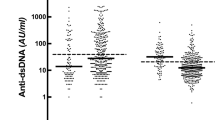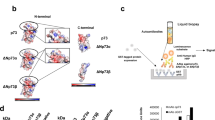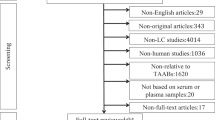Abstract
DURING investigations of the Prague sero reactions for cancer we have tried to identify the substances in the serum, which give the typical polarographic curve when using the technique of Brdička described in our previous letter as preparation (b)1. According to Brdi&cbreve;ka2, this curve form is characteristic for compounds of cystine; the concentration of cystine must, however, be 100–1,000 times greater than that generally found in serum (1 mgm. per cent3), if it is to be responsible for the heights of the curve, found by Brdicka and ourselves in serum. Furthermore, we have found similar curves by submitting urine to the polarograph instead of serum, and we find that the concentration of cystine in normal urine is exceedingly small.
This is a preview of subscription content, access via your institution
Access options
Subscribe to this journal
Receive 51 print issues and online access
$199.00 per year
only $3.90 per issue
Buy this article
- Purchase on Springer Link
- Instant access to full article PDF
Prices may be subject to local taxes which are calculated during checkout
Similar content being viewed by others
References
Bergh, Henriques, Schousboe, [NATURE, 141, 751 (1938).
Brdi&cbreve;ka, Acta internat. Verein. Krebsbekämpfung, 3, 13 (1938).
Brown, Lewis, Proc. Soc. Exp. Biol., Med., 36, 487 (1937).
Waldschmidt-Leitz, Angewandte Chem., 51, 324 (1938).
Author information
Authors and Affiliations
Rights and permissions
About this article
Cite this article
BERGH, F., HENRIQUES, O. & WOLFFBRANDT, C. Prague Sero Reactions for Cancer. Nature 142, 212–213 (1938). https://doi.org/10.1038/142212a0
Published:
Issue Date:
DOI: https://doi.org/10.1038/142212a0
This article is cited by
-
The Polarographic Sero-Reaction for Cancer
Nature (1938)
Comments
By submitting a comment you agree to abide by our Terms and Community Guidelines. If you find something abusive or that does not comply with our terms or guidelines please flag it as inappropriate.



